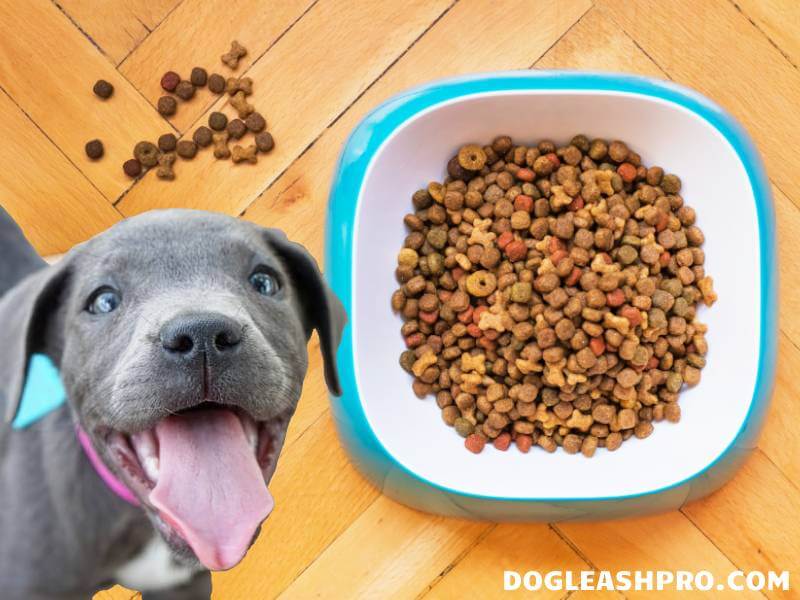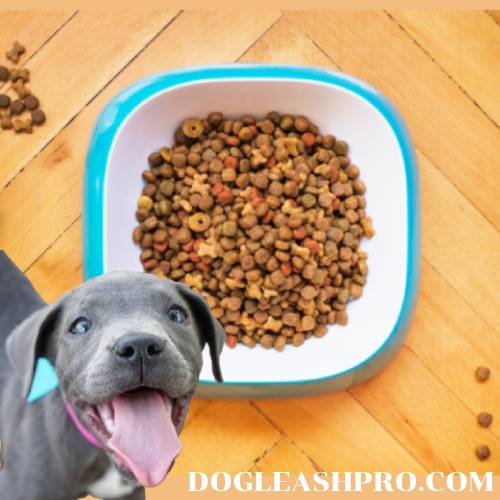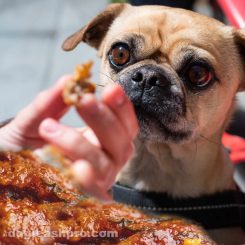
Can 2 month old Pitbulls eat Pedigree dog food? Yes, 2 month old Pitbulls can eat Pedigree dog food in moderation since there are a few Pedigree dog food products that are specially formulated for puppies and contain the necessary ingredients and nutrients that puppies need for proper growth and development of strong bones and teeth.
Table of Contents
Can 2 Month Old Pitbulls Eat Pedigree Dog Food?
If you have a 2 month old Pitbull puppy, what you feed him or her is very important. That’s because at 2 months old, the Pitbull is a very young puppy that needs careful care, nutrition, and attention to grow properly and stay nourished.
Your tiny furbaby is growing so he will need all the nutritious food he can eat. However, you’ll want to make sure that the Pedigree dog food you’re about to feed your canine companion is suitable for him.
Keep in mind that it’s not a good idea to only feed your 2 month old Pitbulls Pedigree dog food. Your 2 month old Pitbulls can’t solely rely on Pedigree dog food alone. Instead, they need their regular nutritious meal. If you would like to add some Pedigree dog food to their regular puppy meal, then that’s fine.
Depending on who you ask, you’ll notice that one owner’s opinion on the best dog food to feed their 2 month old Pitbull puppy may differ from another owner’s opinion.
Regardless of their belief, they can all agree that a 2 month old Pitbull puppy is at its most critical stage of growth and development. Therefore, he’ll need food that is both nutritious and well-balanced.
Fortunately, most Pedigree dog food for puppies are suitable for puppies as young as 6 weeks old. They are also packed full of protein and nutrients that are similar to their mothers’ milk, which means the food is also easier on their stomachs.
Not only do most Pedigree dog food for puppies contain balanced and complete nutrition, but also they are packed full of vitamins, minerals, and antioxidants that our 2 month old Pitbull puppies need in order to have strong bones and teeth. Pedigree dog food for puppies also contains DHA (Docosahexaenoic Acid) which is extremely crucial for your puppies’ brain development.
You may like: Can Dogs Eat Mushrooms?
What is Pedigree Dog Food?
In order to fully understand why 2 month old Pitbulls can eat Pedigree dog food, specifically Pedigree Puppy food, we need to take a deeper dive into what Pedigree dog food is and the ingredients in their food.
Whether you’re a first-time Pitbull owner or have had Pitbulls (or other dog breeds) for many years and are now thinking about feeding them Pedigree dog food, it’s important that you become familiar with this dog food brand before feeding it to your furry companions.
You’ve probably seen the Pedigree dog food at your local supermarket, grocery stores, or pet supply stores. Seeing it often may make you wonder if you should feed it to your four-legged friends.
The Pedigree dog food comes in many varieties depending on the size, age, and breed of your furry companions. It also comes in both dry and wet dog food.
Pedigree dog food is great for all dogs including:
- Puppies.
- Adult dogs of all sizes.
- Pregnant dogs.
- Lactating dogs.
- Working dogs.
- Show dogs.
Next, let’s take a look at the ingredients in both Pedigree dry dog food and Pedigree wet dog food for puppies.
You may be interested in: Can Dogs Eat Orange Chicken?
What is in Pedigree Dog Food?
When it comes to feeding our puppies, it’s important to know that their nutritional needs differ from that of adult dogs. Puppies grow very fast and during this time, their vital organs are still developing and they are building up their bones and muscles.
So does the Pedigree Puppy dog food help our puppies with their growth and development?
What is Pedigree puppy?
Pedigree Dog Food for puppies comes in many different flavors including chicken and steak.
If we take a look at the ingredients in the Chicken flavor of Pedigree Puppy, we see that there are:
- Ground whole grain corn.
- Corn gluten meal.
- Chicken by-product meal.
- Ground whole grain wheat.
- Soybean Meal.
- Meat and bone meal.
- Animal fat (Source of Omega 6 fatty acids) [Preserved with BHA and citric acid].
- Brewers rice.
- Brewers dried yeast.
- Chicken flavor.
- Salt.
- Monocalcium Phosphate.
- Fish oil preserved with mixed tocopherols (Source of DHA).
- Potassium chloride.
- Calcium carbonate.
- Choline chloride.
- Copper Sulfate.
- DL-Methionine.
- Dried peas.
- Dried carrots.
- Zinc sulfate.
- L-Tryptophan.
- Vitamin A supplement.
- Riboflavin supplement (vitamin B2).
- Vitamin B12 supplement.
- Thiamine mononitrate (vitamin B1).
- Pyridoxine hydrochloride (vitamin B6).
- Folic acid.
- Vitamin D3 supplement.
- Vitamin E supplement.
- Niacin Supplement.
- Sodium selenite.
- Potassium iodide.
- D-calcium pantothenate.
- Yellow 5.
- Yellow 6.
- Blue 2.
- Red 40.
Check out: Can Dogs Eat Tamales? (The Corn Husk Is Dangerous)
Corn & corn gluten meal in Pedigree Puppy is safe for 2 months old Pitbulls that don’t have corn allergies
Before you feed your 2 month old Pitbulls Pedigree dog food or Pedigree puppy, make sure they do not have corn allergies or are not sensitive to corn.
Puppies that consume corn food products may suffer from the following symptoms if they are allergic to corn:
- Abdominal cramping.
- Hives.
- Itchy or irritated skin.
- Frequent licking of the skin and paws.
- Frequently biting their paw pads.
- Vomiting.
- Diarrhea.
If you’re not sure whether your 2 month old Pitbulls have corn allergies, we highly recommend that you speak with a veterinarian and begin the necessary allergy tests to find out.
Alternatively, you could take one Pedigree Puppy kibble and break it into two and feed your 2 month old Pitbull puppy half of that kibble to see how they react.
As with any new food, you’ll want to introduce it to your furbaby slowly and gradually.
For puppies that are not allergic to corn, you’ll be glad to know that the corn and corn gluten meal in Pedigree Puppy dog food doesn’t just act as a filler. Instead, they are packed full of linoleic acid, carbohydrates, protein, and antioxidants. Thus, they provide nutritional benefits to our little 2 month old Pitbulls.
The carb from corn is actually good for our puppies because they provide vitamins, fiber, protein, and fat that our puppies need. Fiber is key to ensuring good gut health and keeping our puppies active.
The corn gluten meal you see in the ingredients is basically a reduced, dried form of the corn and it contains more protein.
Read also: Can Dogs Eat Takis? Here’s Our Hot Take.
Chicken by-product meal in Pedigree Puppy is safe for 2 month old Pitbulls
When we see the word “by-product” right after the word, “chicken,” some of us may start to question the quality of the Pedigree puppy food. I know I did!
So I decided to do a bit more research and dig further to find out if the chicken by-product meal in the Pedigree Puppy dog food is safe for our little puppies.
Here’s what I found:
According to the USDA, byproducts include various types of meat. Here’s how they define byproducts:
“Byproducts…(edible offal (including variety meats)… include all parts of a live animal that are not part of the dressed carcass…”
USDA
We also looked into how the Association of American Feed Control Officials (AAFCO) defines byproducts and where they stand on this matter:
“AAFCO’s position is that byproducts can be safely used to provide nutrition for lots of animals…Essentially, a byproduct is what is left over after the intended product has been made. In the case of animal feeds, including pet foods, it’s often the excess materials left over after processing human foods…Many raw commodities, when processed, result in a primary product for human consumption and secondary products mostly (but not exclusively) for animal consumption.”
Association of American Feed Control Officials (AAFCO)
AAFCO added that, “Using primary animal and plant products for humans and their related byproduct materials for animals is a common practice. This doesn’t mean byproducts are unsafe or lack nutrition—they just aren’t part of the original primary products.”
As we can see, byproducts such as that of chicken by-products are any parts of the chicken that have been rejected for human consumption or use and can be expected to be used for animal consumption or pet food.
These leftover parts may include the following:
- Blood.
- Brains.
- Cartilage.
- Fats.
- Feet.
- Glands.
- Heads.
- Intestines.
- Kidneys.
- Ligaments.
- Liver.
- Lungs.
- Skin.
- Spleen.
- Stomachs.
Fun Question: Can Dogs Eat Pepperoni? The Truth!
So is Chicken by-product in Pedigree Dog Food safe for 2 month old Pitbulls?
We can see that although chicken by-products are deemed unfit for human consumption, they can still be used in pet food.
Some leftover parts are used to make dry and wet dog food as it is right after slaughter while other leftover parts require a few more steps in order for them to be made into poultry meal products.
This is a process called rendering, which is when the leftover parts are cooked until the water dries up and then the fat is skimmed away. The remaining residue is then baked and you are then left with concentrated protein powder which is known as by-product meal.
There are usually two grades of by-product meals:
- Pet food grade by-product meal.
- Feed grade by-product meal.
In 2004, a study was published in the Poultry Science Association stating that ped food grade-byproduct meal had the following:
- Higher protein content.
- More digestible.
- More consistent.
- Lower in ash.
Therefore, if you take all of this into consideration, pet food grade by-product meal is far superior to feed grade by-product meal.
From the ingredient list, it’s hard to tell if the Chicken by-product meal is that of pet food grade by-product meal or feed grade by-product meal.
To really know which type of by-product meal it is, we would have to contact the manufacturer.
Also Read: Can Dogs Eat Chicken Noodle Soup?
Two ways to describe By-Product meals
It’s important to point out that there are actually two ways to describe by-product meals. They are:
- Specific animal by-product meals.
- Generic (unknown) by-product meals.
The specific animal by-product meal in this case is chicken by-product. While chicken by-product meals aren’t considered high quality ingredients, they are considered acceptable.
However, when it comes to the generic by-product meals, then it’s a different story since the manufacturer did not identify the source of the meat. Let’s discuss this in more detail next.
Meat and bone meal in Pedigree Dog Food
One type of animal by-product dog owners should avoid is the generic (unknown) by-product. They come in non-specific and vague terms since they did not identify the meat source.
They go by names like:
- Meat and bone meal.
- Meat by-product meal.
- Meat meal.
- Animal by-product meal.
You can see from the list of ingredients in Pedigree Puppy that it contains the “Meat and bone meal” ingredient.
You’ll want to be aware of the fact that generic (unknown) by-product meal can contain meat from the following:
- Dead zoo animals.
- Poultry that were dead on arrival.
- Dying livestock.
- Diseased livestock.
- Euthanized dogs or cats (highly unlikely, but possible).
We want to warn you of this because some dog owners may not feel comfortable with feeding their puppies and canine companions “meat and bone meal” that are from generic or unknown source.
If you’re one of them, you’ll want to avoid buying any dog food products that contain the Meat and bone meal ingredient.
Check out: Can Dogs Eat Brisket?
Is there any nutritional difference between animal by-product meals and regular meals?
When the animal by-product meals are compared with regular meals, studies have shown that the nutritional value are pretty much the same.
Some manufacturers use animal by-products because cost-wise, they are cheaper than regular meat. Animal by–product are used to make doggy food because some manufacturers sees it as cost-efficient, not because they are healthier or more nutritious.
So if you’re buying dog food (Pedigree brand or not), finding the animal by-product in the list of ingredients isn’t really a good or a bad thing, but rather it’s a handy hint that the food may be made with cheaper or more affordable ingredients.
To help you decide whether you should buy dog food that contains by-products in its list of ingredients, here are two important rules that will help you:
- If you don’t feel comfortable feeding your fur babies or canine companions generic (unknown) animal by-products, of which you don’t know what specific animal or parts were used, then don’t buy it. It doesnt matter what brand it is.
- Avoid paying a lot for dog food where animal by-product is listed as an ingredient near the top of the ingredient list.
Handy hint: When looking at the ingredients list, what’s listed at the top of the list means that there’s more of that ingredient in the overall food. Ingredients are usually listed by quantity so it goes from the highest to lowest amount. If you see “Ground whole grain corn” as the first item on the list (as in this case), then it means that this is the ingredient that the manufacturer used most of.
A good rule of thumb when looking at the ingredient list is to always scan the first three to four ingredients. These ingredients make up the largest part of what your furry friends (2 month old Pitbulls) will be consuming.
In the case of Pedigree Puppy Chicken flavor, your 2 month old Pitbulls would be consuming ground whole grain corn, chicken by-product meal, and ground whole grain wheat.
DISCLAIMER: THIS WEBSITE DOES NOT PROVIDE MEDICAL ADVICE
The information, including but not limited to, text, graphics, images and other material contained on this website are for informational purposes only. No material on this site is intended to be a substitute for professional veterinary advice, diagnosis, or treatment. Always seek the advice of your veterinarian or other qualified health care provider with any questions you may have regarding dietary needs.
PEDIGREE is a registered trademark of MARS, INCORPORATED. Dogleashpro does not claim any ownership of the PEDIGREE name, logo, or any identifying mark in any way. This article is for educational purposes only.
Resources:
https://en.wikipedia.org/wiki/Pedigree_Petfoods

With over five years of specialized experience as an animal writer, my expertise lies in dog nutrition, health, behavior, grooming, and training. I am dedicated to delivering helpful and informative content that caters to the well-being of our furry friends. My primary goal is to empower pet owners with knowledge and ensure our canine companions thrive in health and happiness. In my free time, I love volunteering at local dog rescue centers.







